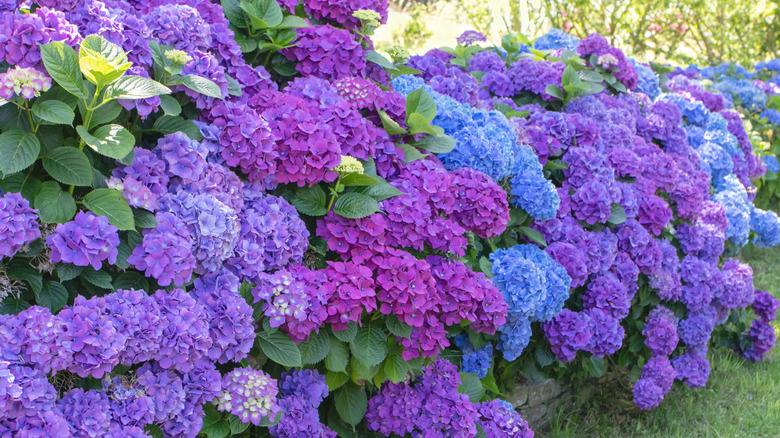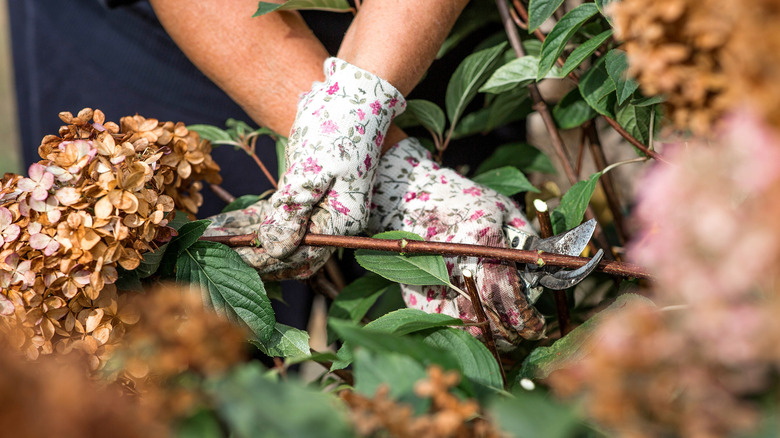Follow These Crucial Steps If You Want To See Your Hydrangeas Thrive In Spring
There's nothing quite like hydrangeas in full bloom, with vibrant, billowing clusters of blossoms in shades ranging from white and blue to purple and pink. Because they are both beautiful and easy to grow and take care of, particularly in USDA hardiness zones 3 to 9, it's easy to see why they are highly popular plants to grow in gardens or containers.
Of course, to make the most of the typical flowering window for these ornamental shrubs –- which may be anywhere from late spring to early fall. This kind of routine maintenance is required every year, typically in the very early springtime. There are many different varieties of hydrangeas, but for most, maintenance means pruning and fertilizing. When and how exactly to perform these tasks (particularly pruning) is dependent on which of two categories the particular species falls into: old wood or new wood.
So what is the difference between these two categories? Hydrangea species that bloom earlier, typically before June, bud on last year's growth –- that is, "old" wood. Those that bloom later do so on the current growing season's new growth, which is "new" wood. You may encounter some exceptions to this rule. Caring for the 'Endless Summer' hydrangea, for example, is a bit different, since it blooms on both new and old wood. Make sure you know which type you have!
When and how to prune old wood hydrangeas
The old wood species are probably what most people picture when they think of hydrangeas: big, fluffy, colorful flowers and verdant leaves. Because old wood hydrangeas –- or bigleaf hydrangea (H. macrophylla) and its cultivar groups such as lacecap and mophead –- will bloom the following year on this year's growth, you should not leave pruning too late. Here's a good rule of thumb for old wood: the later you prune, the fewer blooms you'll see the following year. Pruning can begin for old wood hydrangeas anytime after the spring frosts end. Try not to wait until the fall, or you will be cutting off next year's flowers.
New wood hydrangeas include panicle hydrangeas (H. paniculata) and smooth hydrangeas (H. arborescens). For these types, pruning time is a little more flexible. The rapidly growing panicle hydrangeas can benefit from intensive pruning in late winter or early spring, while the smooth varieties can be pruned back close to the ground in late winter to encourage healthy new growth. Generally, unlike the old wood species, new wood hydrangeas should not be pruned too early, or you will be robbing yourself of this year's blooms!
To prune your hydrangeas, make a heading cut: cut at a 45-degree angle above a large bud, with the high point of the cut approximately ¼ to ½ inch above the bud. Dead wood and much older stems near the base of the shrub can also be cut back to allow for newer, healthier growth.
Pruning and fertilizing new wood hydrangeas
Early spring is a good time to fertilize your old wood hydrangeas for optimal blooms. When choosing the best fertilizer for your hydrangeas, a balanced time-release fertilizer (such as an 8-8-8 or 10-10-10 formulation) mixed into the top 2 to 3 inches of the soil is generally a good choice. Several light applications throughout early spring should yield good results. Keep in mind that the color of bigleaf and French varietals is dependent on aluminum uptake, which in turn is dependent on soil pH. Simply put, alkaline soil produces pink blossoms, while acidic soil produces blue, so make sure to check the levels of your soil and apply acidifiers (to lower the pH) or lime (to increase the pH) when fertilizing in spring.
New wood hydrangeas don't need much fertilizer, but might benefit from a quick-release fertilizer application in spring and summer. Additionally, panicle hydrangeas in particular can benefit from a protective layer of mulch, since they have shallow roots. The colors of new wood hydrangeas are not responsive to soil pH as the old wood varieties are. Different cultivars of new wood species may produce specific colors ranging from pink to red, but generally speaking, new wood hydrangeas produce blossoms ranging from white to light green.


